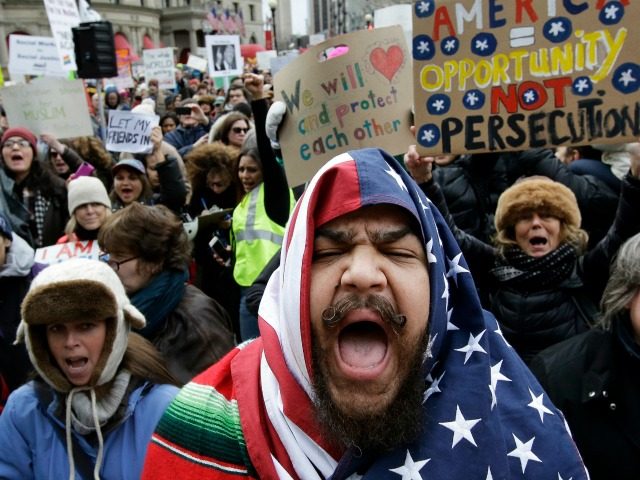President Donald Trump on Wednesday signed and transmitted his decision to trim the 2021 inflow of refugees to under 15,000.
The move continues Trump’s pressure on U.S. companies to hire Americans at higher wages and invest in labor-saving machines, such as high-tech slaughterhouses.
But the labor supply decision was greeted with outrage by the elite left groups, which are paid to distribute refugees to low wage employers round the country.
“In just four years, this Administration has cut annual refugee admissions from 110,000 to a historic low of 15,000. At a time of unprecedented global need, today’s decision is a complete abdication of our humanitarian duty and does a great disservice to our national interests,” said a statement from Krish O’Mara Vignarajah, the chief of Lutheran Immigration and Refugee Service.
President Trump is considering whether to continue halting refugee resettlement into the next fiscal year or further reducing the annual inflow, a new report alleges. https://t.co/AX8du41fKt
— Breitbart News (@BreitbartNews) September 13, 2020
“Admissions of Muslim refugees have declined to approximately 2,500, down from approximately 38,900 in FY 2016,” the statement said.
LIRS is one of several “VOLAGs,” or “Volunteer Agencies,” which import the refugees in cooperation with the U.S. State Department.
“Cry me a river,” responded Ann Corcoran, founder of U.S. Refugee Resettlement Watch, which monitors the VOLAG groups and the impact of their cheap-labor dumping on American towns. “When Trump is reelected, one of his top priorities must be to cement this concept of keeping refugees close to their homes until whatever conflict or environmental crisis has occurred is rectified,” she added.
The administration says it is trying to settle many more refugees in regions closer to their home countries with the money that would otherwise be given to the VOLAG to distribute fewer refugees into Americans’ towns.
In 2019, the administration set a ceiling of 30,000 refugees and then settled just 11,814 migrants in U.S. towns.
Trump on the campaign trail is touting the reform of the refugee programs.
Since 19080, refugee organizations have imported almost 4 million refugees, at the taxpayer cost of at least $30 billion. The flood has been used to impose chaotic diversity on stable communities and provide cheap-labor companies with a flood of cheap labor that helps sideline and impoverish Americans, especially in central states such as Iowa. For example, LIRS claims to have resettled 500,000 refugees since 1939.
Joe Biden wants to admit many more refugees.
Biden’s 2020 plan promises to “reassert America’s commitment to asylum-seekers and refugees,” wipe out President Donald Trump’s asylum reforms, let companies import more visa workers, and let mayors import temporary workers. Biden also wants to accelerate the inflow of chain migration migrants, end migration enforcement against illegal aliens unless they commit a felony, and dramatically accelerate the inflow of poor refugees to at least 125,000 per year.
Roughly 1 million asylum seekers in the United States, alongside the illegal population and the legal visa workers.
The clogged legal system keeps them in jobs for years until their asylum pleas are done.
That's all good, say the Chambers of Commerce. https://t.co/jclfU1M70g— Neil Munro (@NeilMunroDC) October 28, 2020
In contrast, Trump is likely to reject migrants, narrow asylum claims yet further, and fund the transfer of migrants waiting in Mexico back to Latin American countries. His 2020 plan offers broadly popular — but quite limited — pro-American restrictions on migration and visa workers. For example, in many speeches, Trump generally ignores the economic impact of blue-collar and white-collar migration on Americans while stressing issues of crime, outsiders, diseases, or welfare, even though his low-immigration policies have been a popular boon to Americans.
Open-ended legal migration is praised by business and progressives partly because migrants’ arrival helps transfer wealth from wage-earners to stockholders.
Migration moves money from employees to employers, from families to investors, from young to old, from homebuyers to real estate investors, and from the central states to the coastal states.
Migration also allows investors and CEOs to skimp on labor-saving technology, sideline U.S. minorities, ignore disabled people, exploit stoop labor in the fields, short-change labor in the cities, impose tight control on American professionals, centralize technological innovation, undermine labor rights, and to get many progressive reporters to cheerlead for Wall Street’s priorities.
Example #96: President Trump's low-immigration policies raise Americans' productivity.
WSJ reports that meatpacking companies have secretly invested in robots since Trump reduced the supply of cheap labor.
(This also means less $ for investors & Wall St)https://t.co/JTqZdW8lUI— Neil Munro (@NeilMunroDC) July 11, 2020

COMMENTS
Please let us know if you're having issues with commenting.